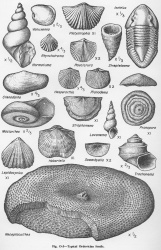Maquoketa Shale Group
Lithostratigraphy: Maquoketa Shale Group
Chronostratigraphy: Paleozoic Erathem >>Ordovician System >>Cincinnatian Series
Allostratigraphy: Tippecanoe Sequence
Primary source
Willman, H. B., Elwood Atherton, T. C. Buschbach, Charles Collinson, John C. Frye, M. E. Hopkins, Jerry A. Lineback, and Jack A. Simon, 1975, Handbook of Illinois Stratigraphy: Illinois State Geological Survey Bulletin 95, 261 p.
Contributing author(s)
H. B. Willman and T. C. Buschbach
Name
Original description
Maquoketa Shale Group (White, 1870, p. 180-182).
Derivation
Named for exposures on the Little Maquoketa River in Dubuque County, Iowa.
Other names
History/background
Type section
Type location
Type author(s)
Type status
Reference section
Reference location
Reference author(s)
Reference status
Stratigraphic relationships
The Maquoketa Shale Group underlies most of Illinois (fig. O-26), unconformably overlying the Galena Group and truncating the upper half of the Galena in the southern part of the state, except for the southwestern area where it rests conformably on the Cape Limestone. It is unconformably overlain by Silurian strata, which locally truncate the upper half of the Maquoketa, except in the southwestern area where it is overlain conformably by the Girardeau Limestone. In western Illinois the sub-Kaskaskia unconformity at the base of the Middle Devonian rocks cuts through the Silurian strata and into the Maquoketa, and farther west near the Mississippi River it completely truncates the Maquoketa (fig. O-26). The sub-Absaroka unconformity at the base of the Pennsylvanian rocks locally cuts through the Maquoketa along the La Salle Anticline (fig. P-4).
Extent and thickness
The Maquoketa Shale Group underlies most of Illinois (fig. O-26). Except where thinned by the unconformities, the Maquoketa is 180 to nearly 350 feet thick.
Lithology
Throughout most of Illinois the Maquoketa Shale Group (fig. O-25) consists of a lower unit, dominantly shale (the Scales Shale), overlain by a middle limestone (the Fort Atkinson Limestone), and an upper shale (the Brainard Shale) (DuBois, 1945; Gutstadt, 1958b; Templeton and Willman, 1963; Buschbach, 1964). In northern Illinois, the Neda Formation (red shale and hematitic oolite) is locally present at the top of the group. In extreme southwestern Illinois, the Maquoketa Group includes only the Scales Shale. Some of the complex facies variations within the Maquoketa Group in Illinois have been shown by DuBois (1945, fig. 3), but his middle zone is not equivalent in all areas to the Fort Atkinson Limestone, which is now restricted to the section in which limestone or dolomite is dominant.
Core(s)
Photograph(s)
Contacts
Well log characteristics
Fossils
The Maquoketa Shale contains two zones with distinctive pyritic and phosphatic beds, called depauperate zones because they contain only small fossils, largely a coquina of mollusks. The Lower Depauperate Zone, at the base of the Scales Shale, is widely present throughout the state, but the Upper Depauperate Zone, near the top of the Scales, has been found only locally in central and northeastern Illinois. The limestone beds and the calcareous shale beds in the Maquoketa Group generally contain a large and varied fauna (fig. O-5). Large brachiopods are common, and branching bryozoans are especially abundant. In a zone near the top in northwestern Illinois, specimens of Phragmopora that reach 4 inches in diameter are locally abundant. Some beds of calcarenite consist largely of bryozoan and crinoidal debris.
Age and correlation
Various group and formation names have been used in differentiating the type Cincinnatian (Weiss and Norman, 1960). In southeastern Indiana, part of the type region, the Cincinnatian strata are assigned to the Maquoketa Group (Gray, 1972). The Maquoketa Group is equivalent to Collingwood and Queenston strata in Ontario and New York, to the Sylvan Shale to the southwest, and to the Reedsville Shale and the Sequatchie Formation to the south and southeast of Illinois.
Environments of deposition
Economic importance
Remarks
References
BUSCHBACH, T. C., 1964, Cambrian and Ordovician strata of northeastern Illinois: Illinois State Geological Survey Report of Investigations 218, 90 p.
DUBOIS, E. P., 1945, I. Subsurface relations of the Maquoketa and "Trenton" Formations in Illinois: Illinois State Geological Survey Report of Investigations 105, p. 7-33.
GRAY, H. H., 1972, Lithostratigraphy of the Maquoketa Group (Ordovician) in Indiana: Indiana Geological Survey Special Report 7, 31 p.
GUTSTADT, A. M., 1958b, Upper Ordovician stratigraphy in Eastern Interior region: American Association of Petroleum Geologists Bulletin, v. 42, p. 513-547.
TEMPLETON, J. S., and H. B. WILLMAN, 1963, Champlainian Series (Middle Ordovician) in Illinois: Illinois State Geological Survey Bulletin 89, 260 p.
WEISS, M. P., and C. E. NORMAN, 1960, American Upper Ordovician Standard, II. Development of stratigraphic classification of Ordovician rocks in the Cincinnati region: Ohio Geological Survey Information Circular 26, 14 p.
WHITE, C. A., 1870, Geology of southwestern Iowa: Iowa Geological Survey, v. 1, p. 296-381.
ISGS Codes
| Stratigraphic Code | Geo Unit Designation |
|---|---|




